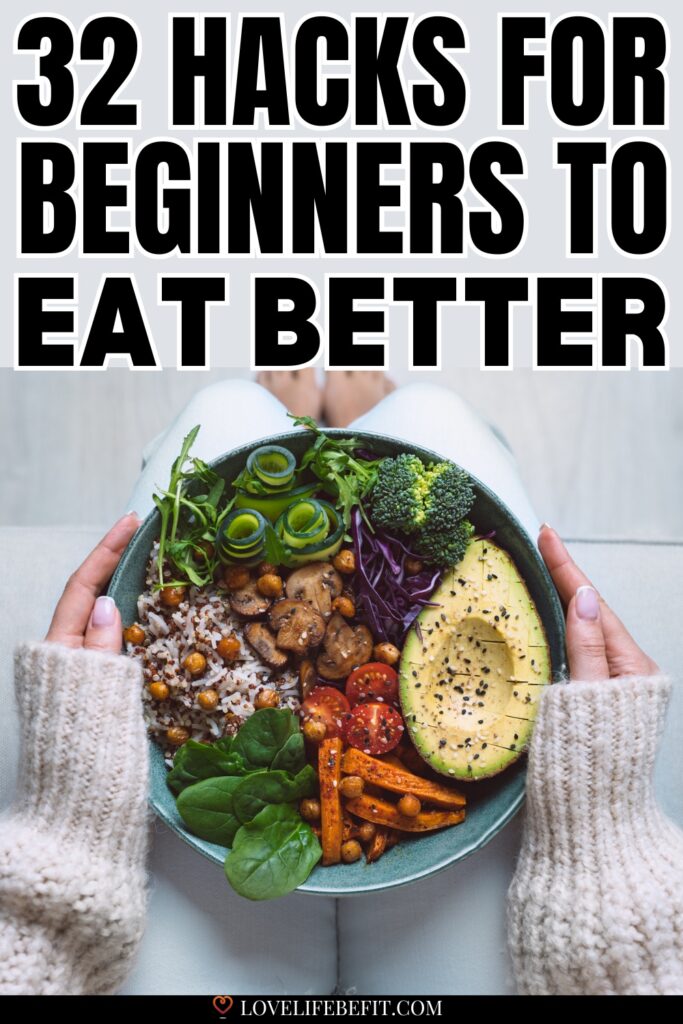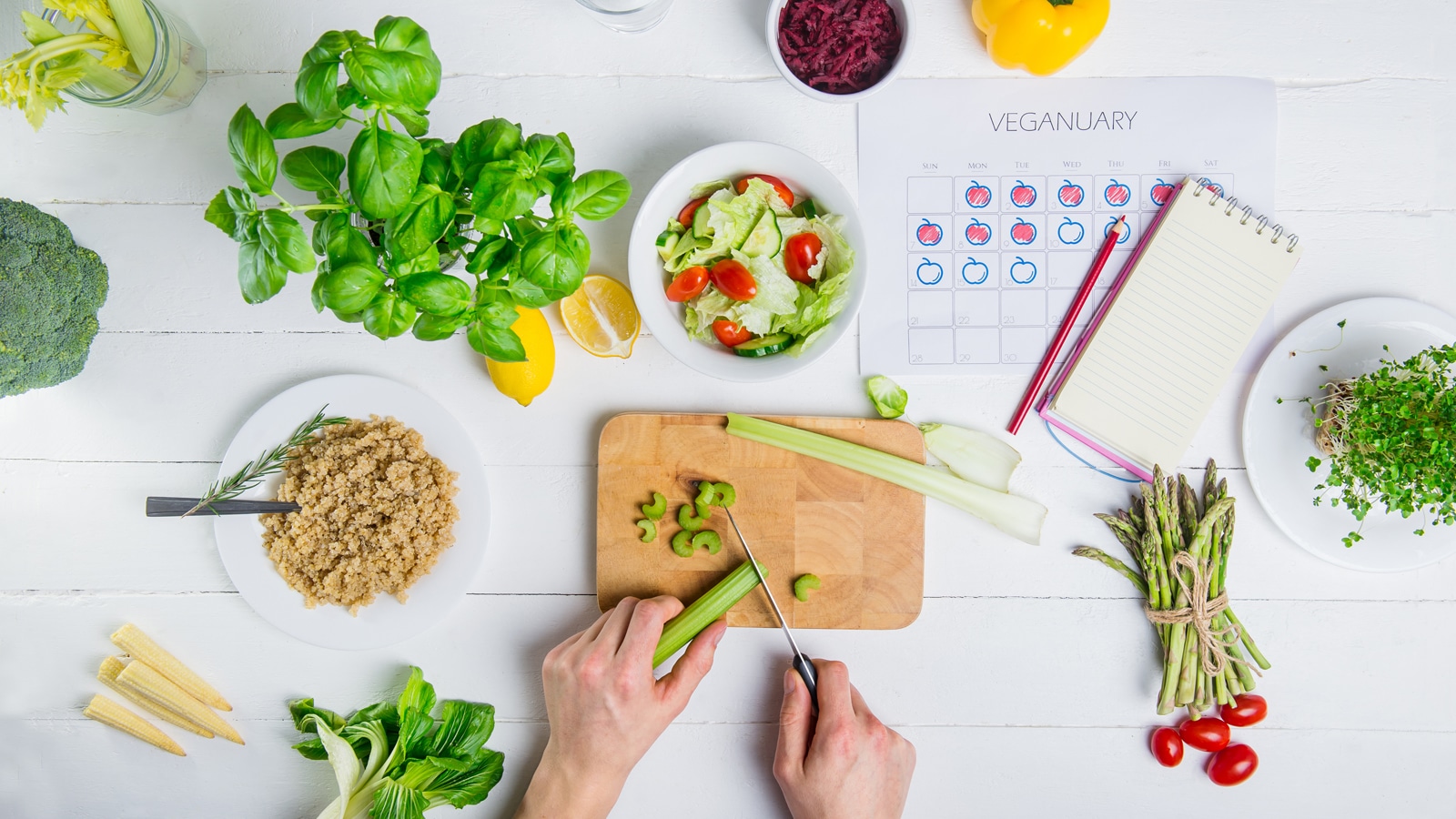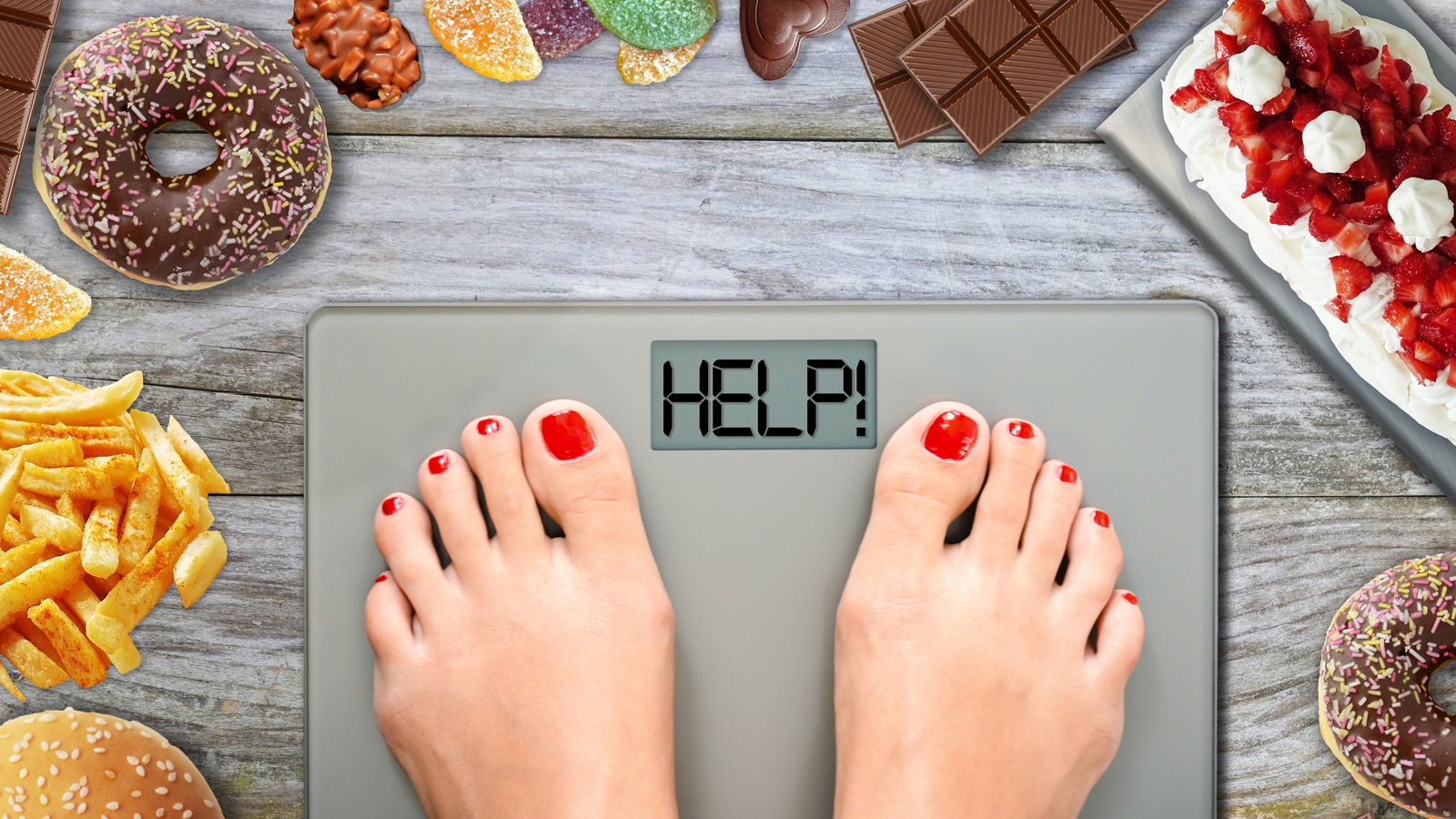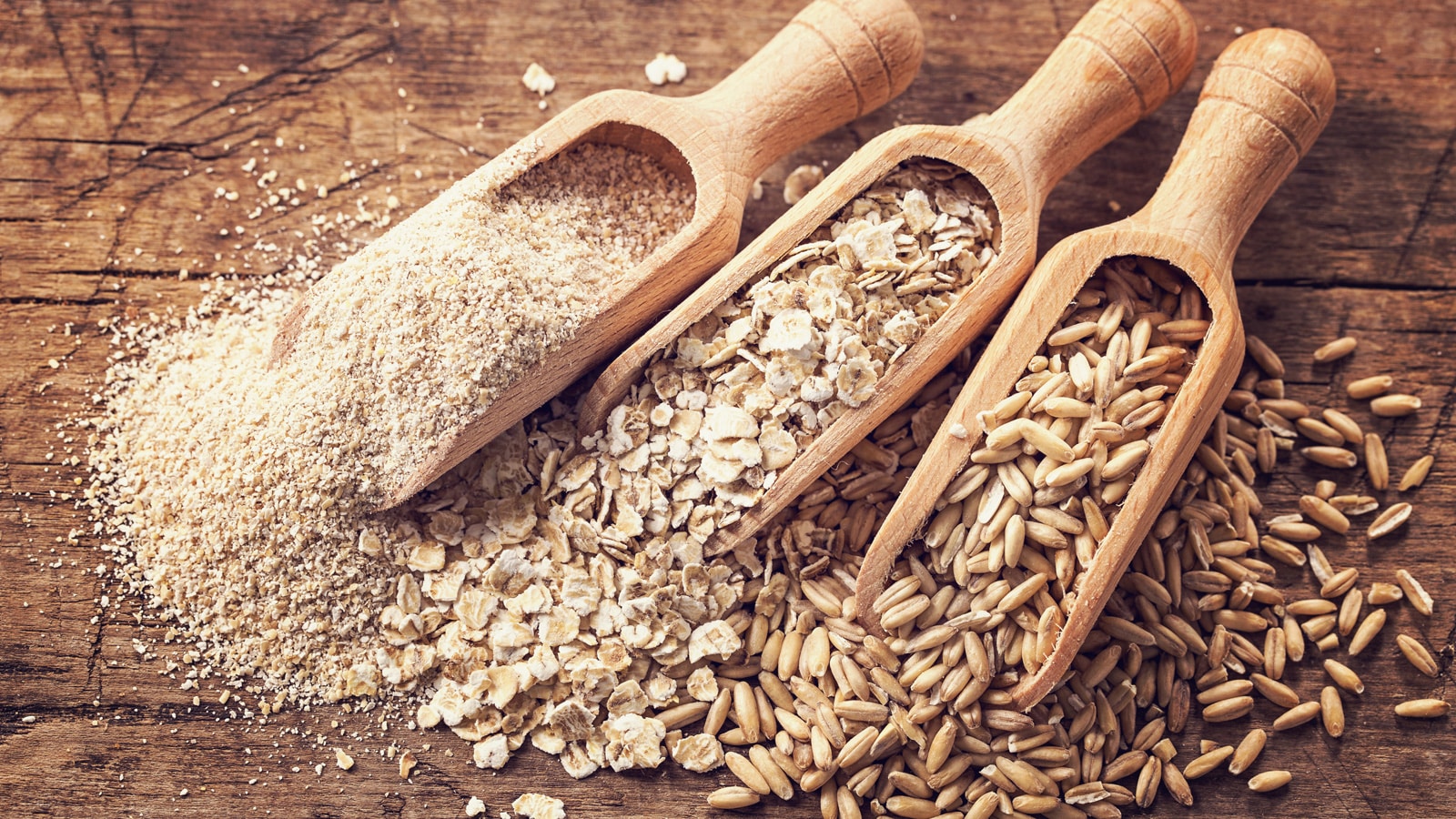32 Healthy Eating Hacks To Eat Better For Beginners
Learn how to eat better with these healthy eating hacks. These how to eat better for beginners tips will show you the right way to start a healthy eating plan.
Learn the habits of people who never gain weight and discover the secrets to eat better and feel better. Healthy eating doesn’t mean eating less it’s about eating when you’re hungry, avoiding foods that make your blood sugar levels skyrocket, and taking small steps to improve your nutrition.
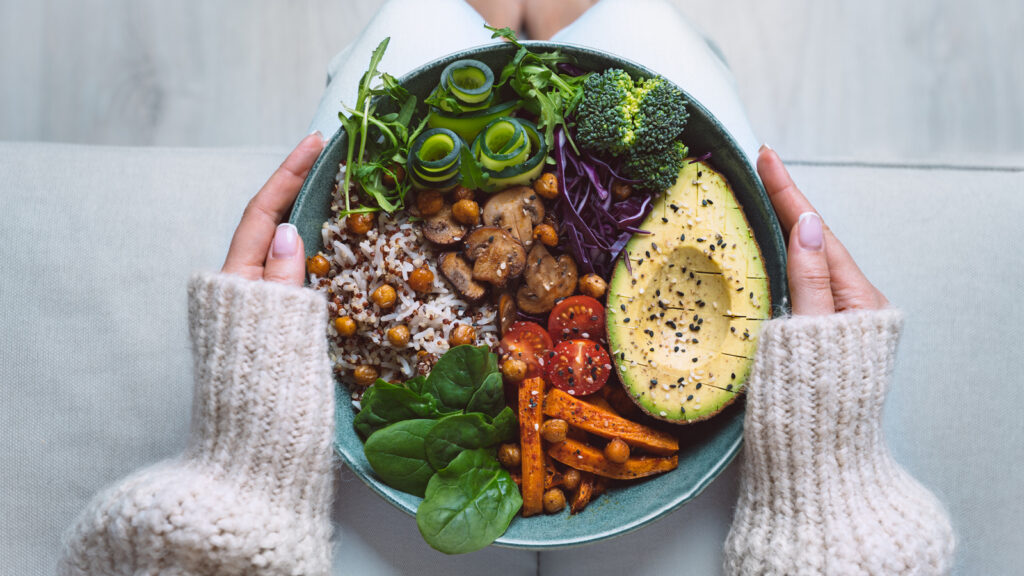
32 Easy-To-Follow Hacks To Help You Eat Better
These healthy eating tips will help improve your nutrition and hit a healthy normal weight.
#1 Set A Goal
Goals are ways of keeping yourself accountable. Don’t just guess your efforts are working, set goals and measure your results. “I think I’m eating better” doesn’t have quite the same impact as “I know I’m eating better”.
Just make sure it’s a goal you can stick to. Be realistic! If you’re 50 pounds overweight telling yourself you’re going to look like Jennifer Lawrence in 3 months doesn’t quite hack it.
#2 Plan Small Steps
You may have a big overall goal but break it down into small steps. It could be as simple as “I’m going to swap my cookies this month for fresh fruit”.
When your first small step becomes a habit you can add in the next one. It all adds up to making progress.
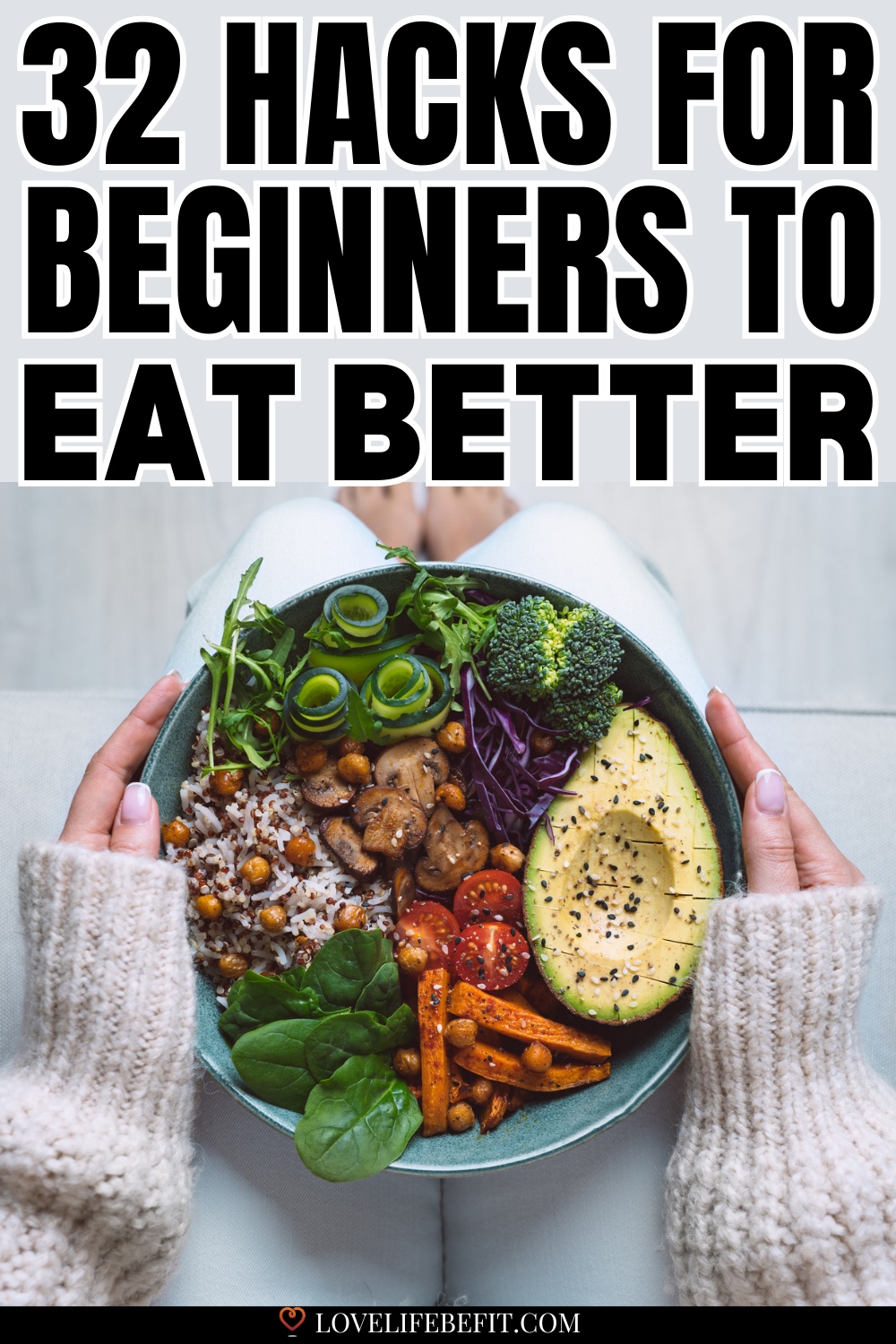
#3 Take Your Before Pictures
Hate taking pictures of yourself? I know – you’re not the only one. It’s still important to have those before pictures. You’re saying to yourself; “I can be better than this“.
#4 Get Out The Tape Measure
Being healthy isn’t just a number on the scale. Record your weight, find your normal weight according to your BMI, but also get out the tape measure.
BMI can be highly inaccurate. When you exercise, your body will change shape. Fat becomes muscle making you stronger but not always lighter on the scales. It’s one reason why your weight loss is slow.
A Tape Measure Is A Good Way To Record Fat Loss
Muscle is heavier and denser than fat, so you may not see much movement on the scales. The tape measure is your answer. Record losing inches.
Take your before measurements now: the widest part of your body, (your butt), hips, waist, top of each thigh, each knee, bust, and top of each arm.
#5 Have A Clear Out
You can have the strongest will in the world, but if there’s a cupboard full of goodies within reach it’s almost impossible to avoid temptation.
Get that junk food out of the house! Bin the ice cream and chocolate chip cookies. Yes, you can do this!
Stock up on healthy snacks instead. Nuts (go easy on quantities), fruit, carrot sticks. Anything to stop you from reaching for food choices you’ll regret.

#6 Get Your Family On Board
It’s easier to follow a healthy diet if your family members or the people you live with are supportive. Hopefully, they’ll agree to eat better with you.
Children who grow up in families making healthy choices are more likely to eat better and maintain a healthy weight as adults.
At least get them to keep the types of food you’re trying to avoid out of sight. That treat cupboard doesn’t have to be next to the kettle!
#7 Meal Prep
There’s nothing like coming home to an empty cupboard when you’re trying to eat better. When you’re tired and hungry it’s easy to end up ordering a takeaway for your main meal. I know! We’ve all been there!
Meal planning helps you avoid lapses by prepping meals of nutritious food. If you know you have a busy week ahead, meal prep on Sunday night. Be prepared!
#8 Drink More Water
Yeah, but what if you don’t like water?
It doesn’t have to be water, just non-sugary drinks. Try and avoid artificial sweeteners too.
Thirst is easy to confuse with hunger. We reach for food when we should be quenching our thirst. Make sure you stay hydrated, especially in the hot summer months.
I can be really bad at this. Blogging away I forget to go and fetch a drink. My solution is to keep a water bottle on my desk reminding me to drink.
Drinking water has also been linked to boosting your metabolism. Now that’s another reason to drink more water!
#9 Lose Weight Slowly
Get this one wrong and you’re heading for a life of misery – yo-yo dieting where you lose too much weight too soon and pile it all back on 6 months later. Yo-yo dieting messes with your metabolism and it becomes harder to lose weight.
Instead, follow these steps to lose weight effectively and keep the weight off for good. Target losing 1 to 2 pounds a week and aim for a calorie deficit of no more than 500 calories.
Find out how many calories you burn a day and how many calories you burn from exercise.
#10 Choose A Diet That Works
I’m not a huge fan of diets. Most overpromise and underdeliver. With most of the lose-weight-fast diets, you’re mainly shedding water as your glycogen stores decline.
Even with the best diets as soon as you stop the diet and start eating normally again, the weight piles back on.
There’s a better way. Instead of following the latest popular book, the latest fad diet:
Eat Real Food Mainly Plants
Eating real food, vegetables, fruit, lean protein, and low GI carbohydrates is key to weight loss. Preparing food doesn’t have to be difficult. A tasty bowl of salad can be put together in minutes and you’ll love some of these easy, healthy, and delicious recipes.
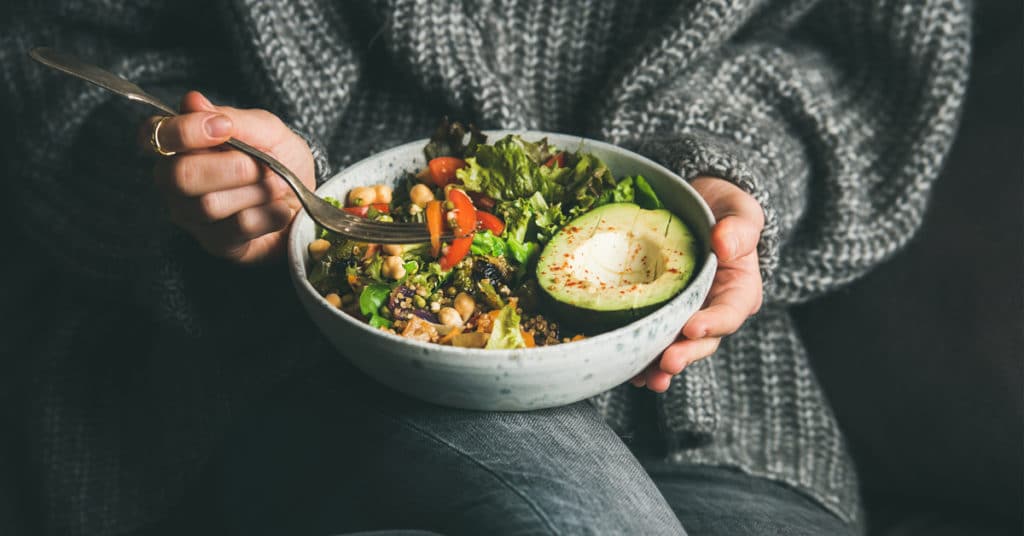
#11 Carb Or Not To Carb
Confused about carbs? You’re not the only one! Keto diet lovers will tell you they’re public enemy number 1!
What is the Keto Diet?
The Ketogenic (Keto) diet strictly controls carbohydrates so that your body starts breaking down its fat stores for energy. Instead of carbs, Keto converts follow a diet full of healthy fats, protein, and leafy vegetables.
Originally the diet was used to control seizures in children suffering from epilepsy and there’s strong evidence to support these benefits. There’s less medical evidence when it comes to weight loss.
A Keto Diet Is Hard To Keep Up
You can lose weight quickly following a Keto diet. It’s just the diet is hard to stick to. Eating only a few extra carbs daily can jeopardize your weight loss goals.
#12 Take The Simple Option
If counting calories and recording your diet in minute detail appeals to your inner OCD that’s fine. Just be wary that overly obsessing over your diet can be a one-way ticket to an eating disorder.
Diet is more important than exercise for weight loss but don’t let it become an obsession. You want to live your life not waste it on the misery of an eating disorder.
Keep things simple. Take the real food route and learn to love filling your plate with colorful vegetables.
#13 Plate Sizes
Plates just get bigger and bigger and today’s chinaware bears little resemblance to plate sizes 50-plus years ago. We’re used to eating oversized portions and have lost the ability to judge a sensible serving size and stop eating when full.
A simple way to lose weight is to replace your plates and bowls with smaller sizes. It’s better to consciously get up and refill your plate with seconds than mindlessly chomp your way through a huge pile of food.
#14 Portion Control
Just like plate sizes, our portion sizes have gotten bigger. McDonald’s may have stopped supersizing back in 2004 but as a rule, we’re still consuming far too many calories in one sitting.
A Big Mac is 563 calories. Add a large fries and you’re topping 1000 calories just for one meal – half the recommended daily calorie intake for most women.
Even with healthier meal choices, it’s still easy to overeat and blow a big chunk of your daily calorie allowance in one sitting.
#15 Eat A Balanced Meal
Fill at least 50% of your plate with low-calorie fruit and vegetables with an emphasis on leafy greens. Just 25% should be fiber-rich carbohydrates and 25% protein. Opt for plant or lean protein sources to help you lose weight.
Healthy fats are essential to your diet – just don’t overdo it. 2 teaspoons of olive oil (10ml) are all you need to complete your healthy plate.
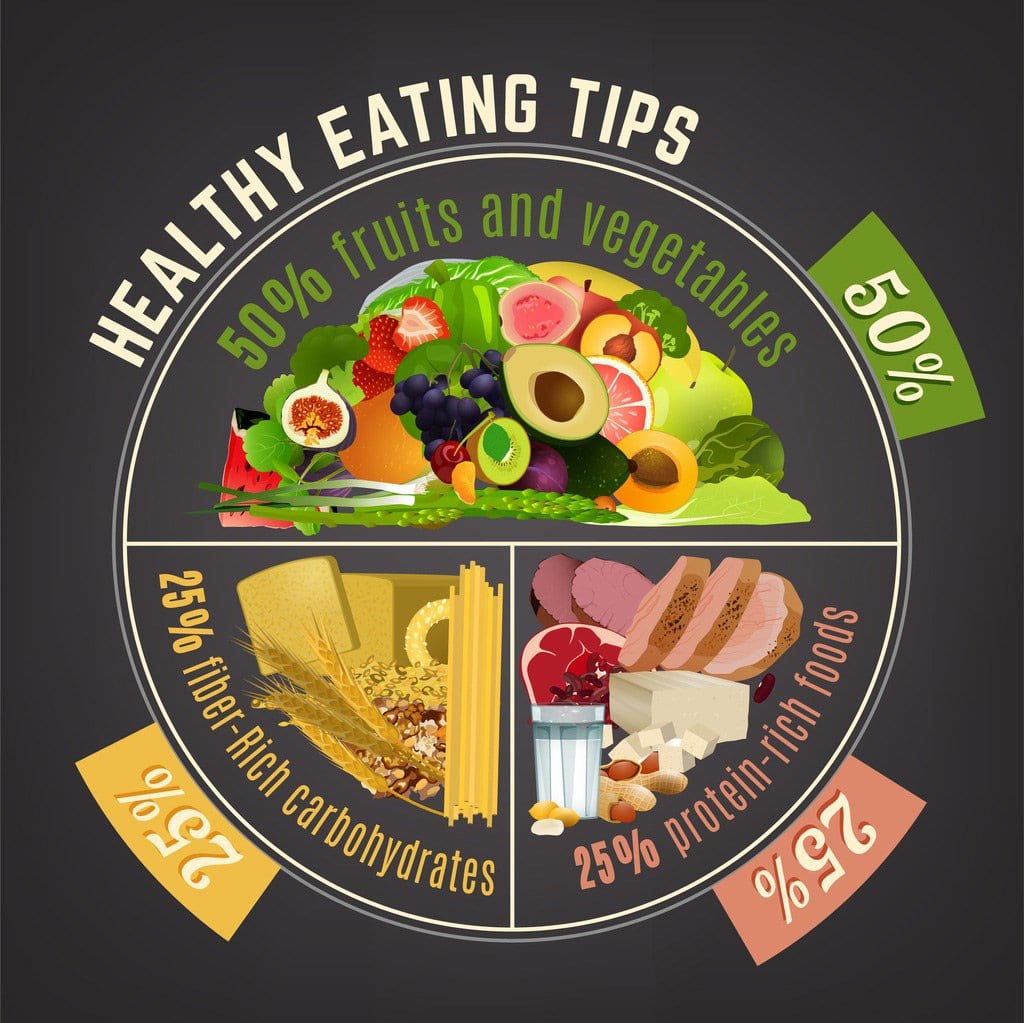
#16 Think Of Food As Fuel
When you exercise, your weight is no longer just cosmetic or about your health. You realize it stops you from doing stuff! Excess weight slows down your running and stops you from walking up hills or achieving more advanced yoga poses.
Committing to getting in shape helps you care about the food you eat. Your food is the fuel your body needs to exercise.
You wouldn’t put cheap fuel in a racing car so why fill your body full of junk?
#17 Work Out Your Ideal Meal Frequency
Not everyone’s the same when it comes to ideal meal frequency. Intermittent fasting, where you aim for daily 16-hour fasts, can be a helpful tool for weight loss.
There’s a strong argument for this approach. Going back to our hunter-gatherer days, food wasn’t served up at regular intervals from a refrigerator.
Try Fasting
The most popular method is 16/8 fasting where you skip or take a late breakfast and stop eating in the early evening. An eating window of 11 am to 7 pm is common. (You can still drink water during your fasting period).
It doesn’t suit everyone. If you’re the type of person who skips breakfast and ends up binge eating later in the day, it’s not for you.
There’s nothing wrong with eating at regular intervals. Try experimenting and see what works for you.
Some people find fasting is better for controlling their weight. For others, it’s eating 3 small meals and 3 snacks a day to avoid getting too hungry.
# 18 Get Plenty Of Sleep
The best health plans are foiled when we’re tired. It’s easier to stay on track with better eating habits if you’re getting plenty of Zzzs. We’re never at our best when we skimp on sleep.
Avoiding comfort eating or saying no to the cream cake your friend’s trying to ply you with, is so much easier when you’re getting 7-8 hours of sleep at night.
#19 Develop A Strategy
There are situations where we’re at our weakest. It could be film night on the couch with a junk food-loving partner or when you arrive home tired after a long day at work.
Work out when you’re most vulnerable and come up with a coping strategy. A simple change could be air-popped popcorn for a film night or a bowl of carrot sticks to take the edge off your hunger when you arrive home from work.

#20 Have Healthy Snacks To Hand
Instead of a sin bin full of chocolate bars, build your healthy bin of snack foods. Anything from bananas to roasted chickpeas or hard-boiled eggs.
Work out your favorite healthy snacks and make sure there’s always something to eat when hunger strikes. If you spend a lot of time in office meetings try and persuade the organizers to provide healthy food options.
#21 Quit Eating Sugar
This isn’t about eliminating sugar entirely from your diet. It will always be present in natural sources such as fruit.
It’s about cutting out the granulated white poison that does nothing for our nutrition and has contributed to the obesity epidemic in the US and UK.
Find out more about what to expect when you quit sugar for a month and follow these tips to quit sugar.
#22 Try Frozen Foods
One complaint about healthy eating is the cost. Yes, fresh fruit and vegetables can be expensive.
An alternative is frozen fruit and vegetables. Picked in peak condition, these can be just as nutritious. Good options for the freezer are peas, beans, cauliflower, spinach, corn, and berries.
#23 Opt For Whole Grains
Coarse-cut oats, brown rice, whole-grain bread, and pasta will keep you full for longer.
These carbohydrates have a low glycemic index (GI) that won’t send your blood sugar levels sky-high. Plus they’re packed with nutritious B-vitamins.
Healthy overnight oats are a great way to start the day!
#24 Start Using A Shopping List
Don’t get carried away when you’re shopping for food – especially if you’re shopping on an empty stomach. (It’s always best to have something to eat before you go to the grocery store).
Instead, use a shopping list. It will help to keep junk food off the menu!
#25 Check Nutrition Labels
Cooking real food and cooking from scratch is always best, but it’s not always possible when you’re time-poor.
If you’re eating processed food, keep your choices simple and check the ingredients. Pasta and pesto sauce is a better choice, and just as quick to prepare as a ready meal.
#26 Make Soup
Everyone loves soup! It’s also highly nutritious and usually low in calories. Plus it’s a great way to use up leftover vegetables and meat.
Making a filling bowl of soup can be as easy as combining your leftover veggies with some stock. Here’s a quick and easy recipe.
#27 Stock Your Pantry
Stock your pantry with basic ingredients ready to quickly produce a nutritious meal.
Fill your pantry with tins of sweet corn, tomatoes, beans, and chickpeas, packets of wholewheat pasta, jars of pesto, stock cubes, and spices.
Keep a supply of fresh onions and garlic and always have peas and other favorite vegetables in the freezer.
This way you can always rustle up a quick and simple meal without speed dialing your local takeaway.
#28 Avoid Low Fat And Diet Foods
Check the ingredients of low-fat alternatives to your favorite foodstuffs and you’ll often find the fat content has been swapped for sugar.
It’s often better to eat a small quantity of your favorite food and enjoy it than be disappointed by the diet version substitute.
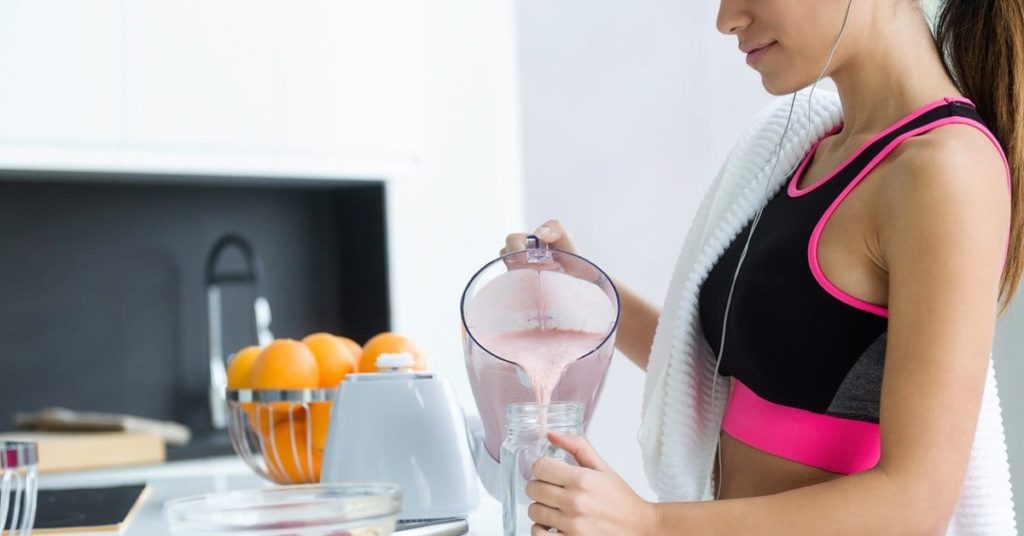
#29 Think Twice Before Drinking Smoothies
Those smoothies and fruit juices may seem healthy but have you ever questioned the ingredients?
A small cup of apple juice can contain as many as 4 apples! That’s a significant calorie hit for just one small cup. Plus it’s full of sugar! Normally when you eat a piece of fruit its fiber reduces the impact of the fruit sugar. In fruit juice, the fiber has been removed and you’re getting one big sugar hit.
Instead, eat your fruit whole.
#30 Choose Fresh Not Processed Meat
The food manufacturers would love you to believe mechanically separated meat is safe to eat. It’s made from a paste of skin and leftover meat waste laden with sodium and preservatives.
If you want to eat better, hot dogs, chicken nuggets, and other dodgy processed meats should be off the table.
#31 Get Rid Of Leftovers
When you’re full – stop eating. It’s okay not to finish everything on your plate.
You can save the scraps for another meal or do yourself a favor and toss them in the bin. Sorry, Gran! The phrase “Waste not want not”, trotted out by the older generation doesn’t help when overeating is such a problem.
(I’m not a fan of wasting food so instead, I meal plan at the start of the week – this way my food waste is minimal).
#32 Treat Yourself
It’s okay not to be perfect. The aim is to eat better rather than obsess over perfection. Follow the eating habits of certain Hollywood celebrities too closely and you could forget how to enjoy life.
Just try to eat better overall. If that means occasional treats of your favorite foodstuff – that’s okay. Eat your favorite foods, just less often and in smaller quantities. Make sure you savor every mouthful!
Try these healthy low-sugar treats and cake recipes.
Eat Better By Making Changes Slowly
Eating better shouldn’t be a chore. The idea is to learn to appreciate and enjoy the taste of real healthy food. If you’re currently a chip and burger-loving vegetable avoider, make changes to your diet slowly.
It’s better to take small steps of constant improvement than make sweeping changes to your diet that you won’t be able to stick to. You’re building good habits. It can take a while but will hopefully last a lifetime.
